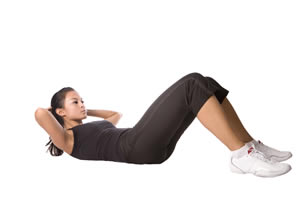Many people have probably heard that the HCG diet doesn’t allow for exercise. This is true on the original protocol as developed by Dr. Simeons. If a person exercised on only 500 calories per day, it was thought that their metabolism may shut down regardless of the help HCG is able to provide. As a result, people were discouraged from doing more than very light exercise on the diet (walking a little during the day). However, on the more robust modern OWL method, people are permitted much more leeway with the methods they choose and how they intend to lose weight. They’re allowed to do some exercising, and also to take in a wider variety of foods than allowed on the original protocol. However, even with these important changes certain kinds of exercise should still be limited and others should be used instead.
 The modern HCG diet allows for what’s called “moderate” exercise. This includes up to 30 minutes of cardiovascular exercises per day, or up to 30 minutes of weight training whichever is preferred. Other alternatives that are permitted include things such as yoga, or swimming for similar periods of time. However, there are several types of exercises that should be avoided while on the HCG diet. For example, high risk activities such as rock climbing or hiking for long periods should be avoided, even if you are not running during these periods. There is a real risk for lightheadedness during long periods of exertion. Beyond that, there are risks to your metabolism if you work out too much while in phase two, as your body will not be able to burn lipids from your cells for energy at a rapid enough pace. If this occurs, your metabolism may slow down and your energy will shrink. It’s hard to recover from this down the road.
The modern HCG diet allows for what’s called “moderate” exercise. This includes up to 30 minutes of cardiovascular exercises per day, or up to 30 minutes of weight training whichever is preferred. Other alternatives that are permitted include things such as yoga, or swimming for similar periods of time. However, there are several types of exercises that should be avoided while on the HCG diet. For example, high risk activities such as rock climbing or hiking for long periods should be avoided, even if you are not running during these periods. There is a real risk for lightheadedness during long periods of exertion. Beyond that, there are risks to your metabolism if you work out too much while in phase two, as your body will not be able to burn lipids from your cells for energy at a rapid enough pace. If this occurs, your metabolism may slow down and your energy will shrink. It’s hard to recover from this down the road.
Selecting an Exercise That Will Work for You
Finding an exercise for you is not always easy. It’s also difficult to make time to do it, so it’s not considered to be a requirement on the original protocol nor the modern approach. However, some light exercise has been shown to help people break through plateaus they encounter in the protocol and is an alternative to doing a fruit or steak day. A good way to introduce exercise into your routine is to start with say 10 minutes of walking in the mornings before work, or to walk to work instead of driving if possible. It’s best to add in exercise in the morning before work so that you don’t make excuses when you’re tired from your job. It will also help you significantly in keeping alert and awake during your work day. You can slowly increase your daily exercise from here, to say 30 minutes in the mornings before you head off to work.
A good alternative to walking or running in the mornings is yoga, as we’ve discussed before. This is a good alternative because it offers users a way to exercise, and build lean muscle. Lean muscle burns fat a lot better than heavy, bulky muscle will. This is because the lipids stored in your fat cells don’t have to traverse as much tissue in order to be burned by your body. Instead, they will be transported and burned more directly the leaner the muscle is. Yoga is also a great way to improve your mood, as it’s been shown in many studies to help release endorphins with regular use. This will help you achieve better results and more easily stick to the protocol in the long term.
